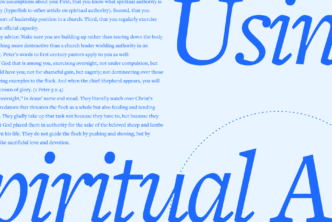It was an innocent question, “Will you use sermon slides when you preach?” I was a first-year seminary student asking a recent graduate embarking on his first pastoral position. The curtness of his answer surprised me, “Not on Sunday morning.”
I couldn’t help but wonder: “Why?” Why did this young pastor have such a negative view of sermon slides? Do they desecrate Sunday morning worship? Are they too shallow? Do they turn properly expositional sermons into merely entertaining ones?
I have come to believe that, when they are used purposefully, driven by the text you are preaching and keeping the people in your congregation in mind, sermon slides can be powerful tools that help drive home eternally important truths.
Here are five reasons why I use sermon slides on Sunday mornings—and why you might consider doing the same. (I have found Proclaim church presentation software to be easy to use and effective for this work—all the images you’ll see have been generated within Proclaim.)
1. Slides communicate God’s word to a variety of learning styles
Expositional preaching is a necessarily auditory medium. It’s proclamation, heralding, announcing, teaching. And for the auditory learner, this works. But if the statistics are accurate, there are more visual learners in our congregations (65 percent) than there are auditory ones (30 percent).1 So I must ask, how are you communicating God’s Word to that 65 percent?
Do not hear me discounting the audibly preached word, of course. Preaching is our calling (2 Tim 4:2). Through the foolishness of preaching, sinners are converted and the saved are sanctified (1 Cor 1:21). Yet I want the message preached to be understood and remembered by all. This is why I provide a visual aid for each sermon point I preach.

For the auditory learner, posting each major sermon point reinforces the sermon structure. For the visual learner, it allows them to see the spoken word. For kinetic (note-taking) learners, the ones who frantically try to write down everything you say, fearful they might miss something—it slows them down and allows them to think about what they are writing. And for the drifters who wander in and out of the sermon (you know the ones), it reminds them of where we are in the text when they do return.
2. Slides maintain sermonic flow
Cross-references are powerful tools in expository preaching. They reinforce Scripture’s unity, remind the congregation of God’s superintending authority over every book, and show the progressive nature of God’s revelation. But the use of cross-references can easily distract from the main passage being preached.
We’ve all heard those sermons where the preacher asks his congregation to turn to every cross-reference. Or when the preacher strings a series of cross-references together to the point that we forget what text we are actually in.
Are there times when your people should turn to a cross-referenced passage? Absolutely. But not every time you bring one up. This is when a sermon slide, like the one below, can be helpful.

It’s a simple slide, easy to produce in Proclaim. No frills. Only God’s Word. Yet a slide that does a variety of things:
- It allows your people to read the cross-reference along with you
- It reinforces Scripture’s authority over your sermon
- It instills God’s truth in their minds
- It also keeps your people in the main text you are preaching (their physical and digital Bibles remain open to that main text)
This is what a well-placed sermon slide can do.
3. Slides cross the cultural bridge into the 21st century
Pictures are powerful. They transform spoken descriptions into concrete images at about a thousand words per image, if the saying holds. This is a necessary principle to remember as you preach, because there is a cultural bridge believers must cross every time they come to the Bible.
Many or most passages of Scripture introduce unfamiliar customs, unvisited places, and ancient structures to our twenty-first-century lives. And it is up to preachers to lead their people across this cultural bridge. This is where a well-chosen slide can help.
Here is an example from a recent sermon I preached from Mark 15:38–39. The sermon was entitled “The Miraculous Cross,” and I was describing the tearing of the temple veil when Christ died. I was drawing out the soteriological significance of that event. I knew I needed to describe Herod’s Temple to set the scene, but I also knew that my words could not paint the necessary picture that my congregation needed to “see.” So I added a series of slides to do what my words could not.
The following is a portion of this sermon with the corresponding slides I used.
***
Think of the temple for a moment—to grasp not only the scene, but also the significance of what is taking place. Within the temple complex, there were three main divisions. The first was the outer court, known as the court of the Gentiles. This was as far as the Gentiles were allowed to go within this temple complex.

Inside this outer court and slightly higher was the inner court—which included the court of women, the court of Israel (where only male Jews could enter), and the court of the priests (where only the priests could go).

But there was also a third division within this complex—the most sacred division: a two-story temple in the shape of a “T.” And within this building was the Holy Place. And beyond that was the Holy of Holies.

Now in the court of the priests, there was an altar roughly forty-five feet square, about fifteen feet high, with a drainage channel that drained the sacrificed animal’s blood down into the Kidron Valley. To the north of the altar was a tethering place where the sacrificed animal would be slaughtered and skinned before being placed on the altar to burn. To the south of the altar, a laver was used for the priest’s washing.

The symbolism of the priest’s court was clear: in order to draw near to God (to enter the Holy Place), there needed to be a sacrifice (hence, an altar). And there needed to be a washing (that’s the laver). All of this was symbolic of man’s filthiness and God’s holiness when it comes to sin.
When a priest entered into the Holy Place, there would be a table of showbread, golden candlesticks, and a golden altar of incense—symbols of union and fellowship with God.

And then from there, within the temple building, a curtain stretched floor to ceiling, ninety feet high, guarding the entrance into the Holy of Holies. Why? Because the Holy of Holies was the inner sanctum of this temple. Only the high priest could enter, and enter only once per year on the day of atonement—and then only with the blood of a sacrifice. The veil was a constant reminder that sin renders humanity unfit for the presence of God, that the dwelling place of God is inaccessible to sinful human beings.
***
An ancient temple none of my people had ever visited and a veil that only the first-century priests had ever seen became, through a series of slides in Proclaim, a window into the first-century Holy Place. But even more, we were able to visualize that grand theological truth of reconciliation and God’s amazing grace at work as his Son died on the cross.
4. Slides illustrate the linguistic nuances in a text
How often have you seen a chiasm in the passage you are studying? How many times have you wanted to show the chiastic structure to your church, but chose not to because it would be too difficult to explain? This is where a well-made slide can help.
Consider the following example from a recent sermon I preached in John 14.
***
Jesus’ words in John 14 are called a “chiasm”—a literary structure or teaching tool that uses repetition of similar words or ideas and organizes them in a parallel fashion in order to form a kind of “X” shape. The point of this structure is for the emphasis of the passage to fall in the middle of the “X.”
Or let’s think of a chiasm in terms of food—a sandwich. And the best kind of sandwich is a BLT sandwich. Who doesn’t like bacon, right?

On each side of the sandwich are two pieces of bread—though that’s not why you eat a BLT. Next to the bread is the lettuce—but again, you don’t eat a BLT for the lettuce. Next to the lettuce is a tomato—but the tomato’s not the star of the sandwich. No, we eat a BLT because of the bacon. The bacon is in the center of the sandwich.
That’s a chiasm. Each part of the sandwich is important. But there is a center to the sandwich—the most essential part.
John 14 is a chiastic BLT. It begins (14:1) and ends (14:27) with the call, “Do not let your heart be troubled” (John 14:1, 27). That’s the bread of the BLT. It’s on each side of the passage. It’s what holds the sandwich (the passage) together. Everything in chapter 14 is about not letting our hearts be troubled.

Then comes the lettuce of the sandwich—in verses 10 and 24, where Jesus says, “The words that I say to you I do not speak on my own initiative” (14:10), and then repeats himself: “The word which you hear is not mine, but the Father’s who sent me” (14:24). There’s the lettuce.

Which leads to verses 15 and 21—and to Jesus’ call, “If you love me, you will keep my commandments” (14:15); a call repeated later: “He who has my commandments and keeps them is the one who loves me” (14:21). You can see the repeated words and ideas in this parallel structure.

This is all by design. Jesus is moving us to the center (and heart) of the passage in vv. 16–20: Jesus’ promise to send the Holy Spirit.
Notice what Jesus says in 14:17: the Holy Spirit will be given and “the world cannot receive [him—but] … you know him” (14:17). This same idea is repeated just two verses later, “The world will not longer see me, but you will see me” (14:19). Call that the mayonnaise of the BLT.

The first half of John 14 parallels the second half of John 14.
Which leaves only one verse left, the central verse—the bacon. This is John 14:18, Jesus’ promise, “I will not leave you as orphans, I will come to you.”

This was the Apostles’ greatest fear. Jesus was about to leave them. And they would be left alone. Like orphans, they were afraid no one would plead their case once Jesus was gone. Like orphans, they feared no one would give them the provision, love, guardianship, protection, and comfort they needed. But what does Jesus say? “I will not leave you as orphans, I will come to you” (John 14:18).
***
By using a series of slides, the linguistic bridge was crossed, and Jesus’ promise was communicated in a clear and relatable way.
5. To picture abstract theological doctrines
I love preaching theology because, as Tozer said, what we believe about God determines everything about us. And yet, in our preaching, we often leave theological principles in the abstract realm.
For example, in a recent sermon from John 17, I referenced the unity shared between the Father, Son, and Spirit. Theologians call this perichoresis, the mutual indwelling of the Persons of the Trinity. And if I left my explanation there, it would be accurate, but it would be abstract. But through the use of one slide, I was able to give a visual picture of the perichoresis of the Trinity.
Here is the sermon excerpt.
***
How united are the Son and the Father? How enmeshed is their will and purpose? Jesus tells us in verse 21, “You, Father, are in me and I in you” (John 17:21). This is the unity of mutual indwelling: the Father in Christ and Christ in the Father.
This is why sometimes you’ll see a series of rings depicting the Trinity. Each ring represents a distinct Person, yet each ring is united and interlocked together—so much so that if you removed one ring, all the rings would fall apart.

That’s the unity Jesus is picturing when he talks about the Father being in the Son and the Son being in the Father.
***
If a picture is worth a thousand words, then a picture is certainly worth a thousand abstract theological principles.
Powerful tools for eternal truth
After beginning my own preaching ministry almost twenty years ago, I quickly learned the value of visual aids. I do not use them for entertainment purposes or homiletical filler. They are meant to support the text, not take over the sermon. And when that is done well, they prove to be powerful tools that drive home eternal truth.






